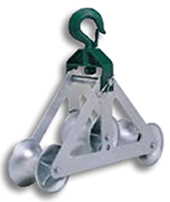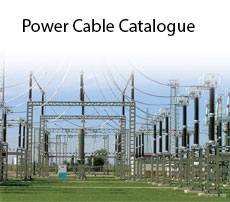
 Technical Information
Technical Information Power And Control Cables
Power And Control Cables Power Appendixes
Power Appendixes CABLING ; Tools , procedure , accessories , laying and handling
CABLING ; Tools , procedure , accessories , laying and handling Cable Pulling
Cable Pulling صفحه Cable Pulling
|
Cable stockings: A pulling rope has to be attached to the leading end of the cable, and a cable stocking is normally used for this purpose. This figure shows types with single and double thimbles. The latter are normally preferred because there is less damage to the cap on the cable end if the pulling load is high. |
||||
 |
 |
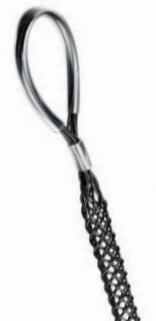 |
 |
 |
| Single Eye | Double Eye | Single Weave | Double Weave | |
|
Pulling eyes : With a stocking, the load is initially taken by the external cable components and is transferred by frictional forces to the conductors. If the load is high it may cause stretching of the outer layers and to avoid this a pulling eye may be plumbed to the armour, sheath and conductors to ensure distribution of the load across the whole section. Many designs of pulling eye are available for different types of cable. Some are tubular with the conductors being sweated inside the tube and the metal sheath plumbed to the outside. Following figure shows a pulling eye which can be adapted for most cable designs. It is not a pulling eye in the strict sense, as it is only a means of anchoring the conductors and sheath in the cable end, and a stocking is necessary. |
||||
 |
||||
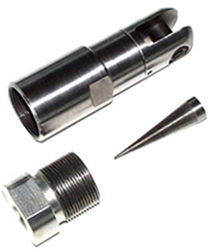 |
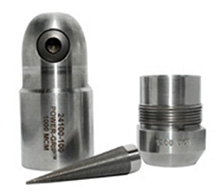 |
 |
||
|
Power winches : Power winches fall into two categories: (a) compact lightweight designs utilising either a small petrol or compressed air engine as the power unit. Following figure shows a typical example which is suitable up to 2 tonnes safe working load with speeds of 5-8 m/min. (b) medium weight designs suitable for 2-4 tonnes, the larger sizes having a diesel power unit. Instead of relying on a direct pull these larger units utilise a pair of ‘bull wheels’ for wire bond haulage as illustrated in following figure. With winch pulling, it is important to take steps to keep the pulling load to a minimum. The drum position should be chosen so that the longest length of straight trench is at the pulling end with any severe bends as close as possible to the drum. |
||||
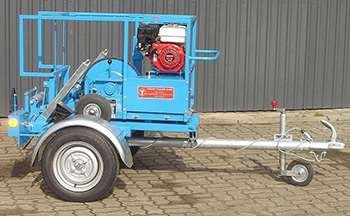 |
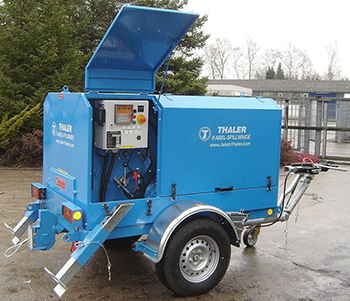 |
|||
| Lightweight winch | Diesel driven winch | |||
|
Pulling tension in a wire bond can be reduced by passing the bond through a snatch block where the trench changes direction. The pull is stopped just before the cable reaches the snatch block so that the bond can be removed from it. This arrangement also prevents the bond from causing damage by scoring the skid plates on the inside of the bend. An alternative procedure for pulling by winch is the continuous bond method. Instead of attaching the bond to the leading end of the cable, the cable is lashed to the bond at about 1 m intervals. This method is mainly required for heavy cables and is seldom needed for distribution cables |
||||
 |
 |
|||
| mechanical actuated cable drum transport and laying trailer | cable laying machine pushing pulling | |||
|
Preparation of the trench : Preparation comprises the installation, as necessary, of skid plates, rollers etc., and paying out the winch rope if using power assistance. Typical rollers and dual purpose rollers are shown in following figure. Cable rollers are necessary to prevent the cable from touching the ground and should be spaced a maximum of 2 m apart for normal size cable. With heavy cables this spacing may need to be reduced to 1.2 m. Correct positioning is important to keep the friction load component to a minimum. Ducts should be clean and smooth and fitted with bell mouths at entry, and also at exit if followed by a bend. The pulling tension is determined by a summation of the weights of cable up to a point of friction multiplied by the coefficient of friction at that point. Conditions vary widely according to cable type, cable finish and bend in a route, but a general average for the coefficient of friction is around 0.25. Under difficult conditions in ducts it may increase to 1.0, and in such situations graphite lubricants should be applied at duct entries to reduce the friction. |
||||
|
Cable Pulling : The cable should preferably be drawn to its final position in a continuous manner. During stops, it will settle between rollers and may cause high strain on men and machines during re-starting. Whether the pull is manual or with a winch, it is necessary for one man to be stationed at the drum with a plank wedged against the wing so that over-running of the drum is prevented if pulling stops. Otherwise many loose turns can easily develop on the drum. Heavy lead sheathed paper cables in long lengths may need very large gangs of men if winch pulling is. not used. However, because of the large reduction in cable weight, only four to five men are needed for a 200 m length of 11 kV cable with corrugated aluminium sheath for an average route. Polymeric cables having no metallic sheath are even easier to install. When pulling by a winch it is advantageous for the cable end to be taken by hand as far as possible before attaching the winch rope. This allows the leading cable rollers, skid plates etc. to take the load and settle under well controlled conditions. The winch operator must carefully observe the dynamo meter to prevent overloading. On long pulls, good communication is essential, preferably by radio. |
||||
| Cable Pulling accessories | ||||
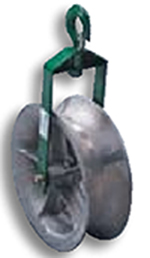 |
 |
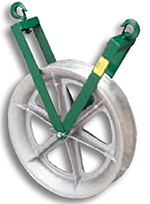 |
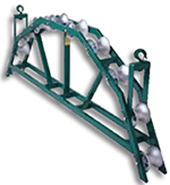 |
|
| Hook Sheave | Hook Type Sheave |
Right Angle twine Yoke Type Sheave |
Radius cable Sheaves | Triple Sheave cable guide |
 |
 |
 |
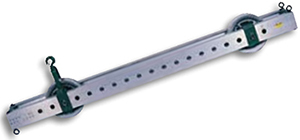 |
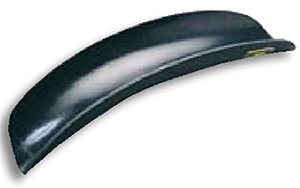 |
| Feeding Sheave | Tray Type Sheaves | Cable Tray rollers | Manhole Sheave | Cable guide |


